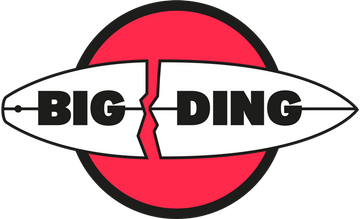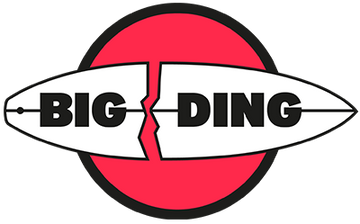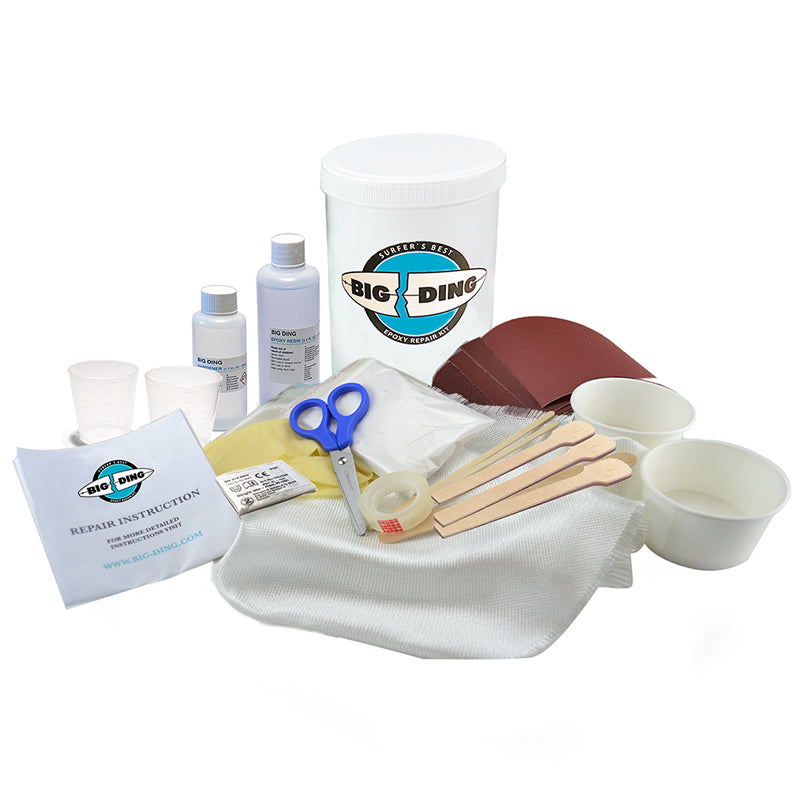
SURFBOARD REPAIR
Repair your surfboard like a pro!
Here you can find everything you need to know about surfboard repairs! From step-by-step instructions, to detailed information and video tutorials , to a large selection of suitable surfboard repair sets in our online shop!
Big Ding repair products are manufactured in Germany and Europe to the highest quality standards. Our sets are suitable for all types of surfboards and are most commonly used for windsurfing board repairs, alongside wave, kite and SUP boards . Scroll down for our instructions and FAQs . Take a look at our surfboard repair wiki to find a comprehensive collection of the basics for a professional board repair.
Surfboard Repair Guide & FAQs
- Which types of surfboards can you repair with Big Ding Repair Kits?
- What damage does your surfboard have
- Repair yourself or repair shop
- epoxy or polyester
- Our bestsellers
- Big Ding Repair Instructions
- video tutorials
1. What types of surfboards can you repair with Big Ding?
Our Big Ding Surfboard Repair Kits are versatile and allow you to repair a wide range of surfboard types, such as wave surfboards, windsurfboards, wake and kite surfboards and SUP surfboards. Whether shortboards, longboards, fishboards, funboards, mini mals or retro boards, you will find the right repair kit for your epoxy or polyester surfboard with us!
2. What damage does your surfboard have?
There are several types of surfboard damage that can occur. Here are some common examples:
Dents: Dents are indented areas on the surface of the surfboard. They can be caused by falls, collisions with other objects, or the weight of the surfer. Dents can weaken the structure of the board and affect its performance.
Cracks: Cracks can occur when the surfboard is subjected to strong pressure or impact. They can be in the surface layer of the board or deeper into the material. Cracks should be repaired to prevent further water ingress and worsening of the damage.
Fin box damage: The fin box is the holder for the fins on the underside of the surfboard. Impacts or heavy loads can damage the fin box. This can lead to the fins no longer holding properly or breaking out of the board.
Delamination: Delamination occurs when the layers of surfboard material separate from each other. This can be caused by water infiltration, heat or damage. Delamination can compromise the structural integrity of the board and should
be repaired.
Nose/Tail Damage: The nose and tail of the surfboard are often vulnerable to damage as they are exposed to the most impact. Damage can take the form of dents, cracks or chips and should be repaired to maintain the performance and durability of the board.
Rail Ding: A rail ding occurs when the edge (rail) of the surfboard is damaged. This can be caused by collisions with other boards, rocks or hard objects. Rail dings can result in cracks, dents or chips on the edges and should be repaired to avoid affecting the performance of the board and preventing penetration
of water.
Board Finishing: Scratches and scuffs can occur from friction with sand, rocks or other hard surfaces. They can affect the aesthetic appearance of the board but usually do not have a major impact on performance.
3. Repair yourself or take it to a repair shop?
If your surfboard is damaged, you may want to consider repairing it yourself. DIY repairs can be a rewarding experience that puts you in control of the repair process and allows you to hone your DIY skills. With a variety of resources and guides online, you can learn how to repair dents, patch cracks, or remove scratches. DIY repairs can save you time and money by not relying on the services of a repair shop. It's important to be realistic about whether you have the skills and the right tools for the repair at hand. However, for more complex damage or uncertainty, it's always advisable to take the surfboard to a professional repair shop to ensure repairs are done properly and last.
4. Epoxy or polyester?
Epoxy or polyester repair kit? Which surf repair kit should you use for which surfboard? The core material is crucial. Polyurethane (PU), expanded polystyrene (EPS) or extruded polystyrene (IX-PS, XPS) is usually used here. While polyester surfboards with a PU foam core can be repaired with polyester or epoxy resin, epoxy surfboards with a polystyrene core can only be repaired with epoxy resin. So, to be on the safe side, you should use epoxy resin if the construction is unknown.
5. Our bestsellers
Section is currently in progress.
6. BIG DING REPAIR INSTRUCTIONS
The following step-by-step instructions show you how to cleanly repair a standard scratch in your surfboard rail using one of our Epoxy or Polyester Repair Sets Basic, Pro, or X-Pro. (This section is currently under construction.)
7. VIDEO TUTORIAL: NOSE DING
In this video, Tao shows how you can repair a broken nose easily and professionally yourself.
Our products























